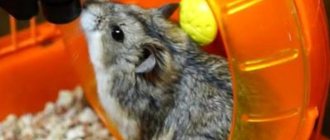Roborovsky's hamsters are charming miniature rodents with round ears, a snub-nosed muzzle, a beautifully colored coat and a peaceful character. These rare animals are often confused with cheaper jungarians. Therefore, before purchasing them, it is recommended to find out what Roborovsky hamsters are and how to create the most comfortable conditions for them.
General description of the breed
Roborovsky's hamster (Phodopus roborovskii) is the most striking representative of the dwarf breeds of the hamster family. Refers to the species of hairy-footed hamsters. Lives in Mongolia, adjacent areas of China and Russia. The body of adult individuals reaches a maximum length of 5 centimeters, weighing approximately 30 g. The species is named after the Russian naturalist V.I. Roborovsky. It is not particularly popular among breeders, because there is essentially nothing to breed. It's really very small. No fur from it, no meat... (just kidding). Look at the photo, isn't it cute?
This is how he is, a small and gentle animal, discovered by V.I. Roborovsky.
The hamster is very small. It does not have stripes on the back, characteristic of a number of other larger breeds, which is very clearly visible in the photo above.
One might get the impression that Roborovsky's hamster is tailless. In fact, every healthy animal has a tail. It’s just that the hamster is famous not only for its smallest body size, but also for its tiny tail. So tiny that it is practically invisible. It is well hidden somewhere in the fur, closer to the..., sorry, butt.
Purchasing a cage
As previously mentioned, it is extremely important to create comfortable living conditions for your pet. Therefore, in addition to answering the question of how much a hamster costs, you need to think about where the hamster will live, that is, buy a cage for it
Of course, a cage or enclosure is the most comfortable housing that you can provide for your pet. Firstly, its open walls do not prevent the penetration of air, and secondly, the wire on the sides makes it convenient to attach various devices, from drinking bowls and feeders to mirrors and toys.
When choosing, you should start from the fact that the animal needs a cage measuring at least 50 cm by 30 cm. It is also better to give preference to a house with rods located transversely, preferably so that the tray does not extend. As for the price of the cage, the average cost is about 700 rubles. If you want a larger home, equipped with a variety of fixtures, the purchase may cost several thousand rubles. In addition, the price will vary depending on the region, for example, in Moscow the cages are the most expensive, in Vladivostok - the cheapest.
Breed Features
The animal can boast (although, do people boast in such cases?) not only with a very small tail. This is not their only feature. They are very peaceful and practically do not bite. Even if you miraculously provoke his wrath, he will not harm you. Their teeth are completely incapable of biting through human skin. Their eyebrows also stand out. Well, like eyebrows... eyebrows. They are also tiny. They are usually lighter in color and are clearly visible on the face.
Ladies and gentlemen, attention to the screen! Here they are, those same famous Roborovsky eyebrows!
In addition, hamsters are very timid. They are very difficult to tame. Perhaps that is why they are so poorly distributed and known.
IMPORTANT: the bars of a regular cage will not hold them. Most of them will pass through it as if through a door. We will tell you below how to properly arrange housing for such a baby.
Breeding at home
Pairs need to be formed in infancy. If this was not possible, then the adults should be given time to get used to each other. At the pet store you can purchase a special grid for the cage, which will allow the animals to sniff, but not make contact, this will eliminate conflicts. The grate is removed after eight to ten days.
The duration of pregnancy is 25 days. At this time, you should not disturb the pregnant woman; she may show aggression and bite. Pay special attention to nutrition; your diet should be as varied as possible. Arrange her home properly. Give the opportunity for privacy; for this purpose, install an individual house, or better yet two. Pour some sawdust, and with their help the expectant mother will make a nest for her offspring.
Female Roborovskis are not as fertile as females of other species. The litter does not exceed six cubs. Hamsters are born hairless and blind. After a week of life, their bodies become covered with fluff. They become independent within two weeks. Baby purees and cereals are suitable as complementary foods. It is better to hold off on fruits and herbs so as not to cause loose stools in babies.
How to distinguish a Roborovsky hamster from a dwarf hamster
Despite the noticeable differences in the size of the body and tail, representatives of these two breeds are sometimes confused. This does not threaten people who understand. However, for amateurs (and there are about 90 of us) it is better to know the main characteristics of the Roborovsky hamster and its difference from the dwarf hamster. At least in order to better understand who is offered to us in the pet store.
The Roborovsky hamster differs from the Djungarian in the following ways:
- The dzhungarik has a dark stripe running down its back, forming something like a diamond on the top of its head. The Roborovsky hamster has no stripes at all.
- Dzungarik is a little larger. The size of an adult Djungarian hamster is on average no more than 8 centimeters. Roborovsky's hamsters - maximum 5 cm. Don't worry, you won't have to go to pet stores with a ruler. It is enough to see them together once to notice this difference in size by eye in the future.
- Roborovsky's hamster is less willing to make contact. If you see that the baby is asking to come to you, it means that this is a representative of the breed that is sick in the head. Or is it just a different hamster. These differences are enough for amateurs. Remember these 3 points and you will not have any problems understanding where the Djungarian hamster is and where the Roborovsky is.
Now, knowing all this information, take a look at the title photo of the article (the largest one, where there are 3 hamsters). The most attentive of you will easily find a Djungarian hamster there. I specially made a collage of photographs of different breeds to make the differences between them clearer. You can even leave a hint in the comments for those who do not have such keen eyesight.
Distinctive features of the species
- The length of the body is 4–5 cm. For comparison: the Djungarian hamster has a body length of up to 10 cm, a tail of up to 1.8 cm.
- The weight of an adult is 22–26 grams.
- The coat is soft and fluffy, longer than that of other dwarf hamsters.
- Wide head with upright large gray ears.
- Large round black eyes.
- A miniature tail that is almost hidden in the thick fur.
- Flattened muzzle.
- 4 toes on the front paws, 5 on the hind paws.
- The soles of the paws are covered with hair.
- Excellent vision.
- Despite the habit of stockpiling, there is no need to hibernate.
- Good harmony with relatives of the same sex.
- It bites extremely rarely and is almost painless.
- They become sexually mature approximately 18-20 days after birth.
- The number of hamsters in a litter is on average from 3 to 5 (in very rare cases up to 6 – 7).
- They are not used in laboratory research due to their more difficult breeding in captivity than other hamsters.
- Very active temperament: constantly on the move, scurrying around, fidgeting, unable to sit quietly in his arms.
Interesting: thanks to the enormous contribution of Russian zoologists to the breeding of dwarf hamsters, representatives of this breed are usually called “Russians”. The Roborovsky hamster is also often called the winter white hamster.
Colors of the Roborovsky breed
Hamsters come in a variety of colors and colors. Every lover will find a pet to suit their taste and color preferences. The choice is wide. Many people prefer the agouti color and consider this color to be one of the most beautiful (I am one of them). In the photo below is a typical representative of the Agouti color Roborovsky breed:
Photo from the site roborokus.ru
In addition to agouti, you can find the following colors:
- platinum;
- variegated (usually white interspersed with light brown);
- husky (no, this is not a black and white northern hamster with blue eyes, just white with a red top);
- husky cinnamon - mustard color with a more yellowish muzzle;
- variegated cinnamon - the same as variegated, but with mustard splashes;
- white – snow color;
Natural habitat
The hamster is distributed almost everywhere on the Eurasian continent: it can be found in European countries and in some regions of Russia. Mainly prefers to settle in steppes, forest-steppes, meadows, and floodplains. It does not go high into the mountains - the maximum height above sea level where the animal can be found is 1.5 km.
Under some circumstances, it can settle even next to a person: in gardens and vegetable gardens. Particularly large numbers of rodents live in areas of active farming. They say that the animals were even found on the territory of new buildings, which were once fields or vegetable gardens, where the animals adapted to existence.
How long do Roborovsky hamsters live?
If you are thinking about purchasing a pet of this breed, then there is another important question, the answer to which is better to know in advance: how long does a Roborovsky hamster live? But here, the smallest animal can bring a very big surprise. The fact is that Roborovsky hamsters have a high life expectancy compared to other breeds. These centenarians managed to maintain their natural immunity. They rarely get sick, so in good conditions they can live as long as 4 years. At least in some ways this little guy is breaking records.
Overheads
It cannot be said that a hamster is an expensive pet to keep, but it does require certain expenses: food, filler, mineral stone, treats, vitamins, sand for bathing, a drinking bowl and other accessories.
Some people think it is acceptable to keep a hamster in a glass jar and feed it scraps from the table. In this case, expenses tend to zero, as well as the health and happiness of a small pet. If you create a comfortable living environment for a rodent, the costs will be tens of times more than the cost of the animal itself, taking into account how much a dzhungarik costs on the market. A good cage for a hamster is not cheap.
What to feed
If you look at the list of products, you might think that this is the diet of a serious athlete. Roborovski's hamsters need both plant foods and animal protein. For proper development and long life, it is very important to feed them correctly. The more varied the list of products consumed by the animal, the better.
Before creating a menu, especially if you want to treat your baby to something exotic, I strongly recommend looking through the section “Can hamsters…”
Basically, you can feed the following foods:
- grain mixtures (purchased and homemade);
- vegetables (except eggplants and hot peppers);
- fruits (except citrus fruits);
- greens (hot and spicy should not be given);
- sprouted wheat grains;
- millet;
Mandatory products in the diet of the Roborovsky hamster
Protein is a very important food in your pet's diet. These rodents love to eat cottage cheese, chicken eggs, various fish and some worms, mainly mealworms. You can also pamper them with fresh, high-quality chicken meat. This meat will be especially useful for pregnant females and for the development of future offspring.
Harmful products
Eliminate everything spicy from your diet. Hamsters should not be given anything from our table. Do not use canned food, any expired food or spices/condiments. You should not pamper them with smoked food, chips, crackers, French fries, beer, and so on. They are very sensitive to junk food. An incorrect diet can very quickly undermine the health and immunity of a baby.
You will do your pet a great service if you protect him from junk food. Feed him exclusively healthy and wholesome food.
Diseases
The Roborovsky hamster has enviable health. No predispositions to certain diseases have been established during their breeding. The main thing is that all conditions for a full life are created: proper maintenance and feeding. Like other hamsters, the Roborovsky may suffer from:
- Bites and injuries received in fights with other hamsters.
- Obesity.
- Damage and inflammation of the cheek pouches.
- Baldness (usually from a lack of vitamins).
- Eye diseases (conjunctivitis and keratitis, they are caused by microtraumas of the eyes and infections in them).
- Diseases of the digestive system (constipation, diarrhea, caused by poor diet).
- Dental diseases.
- Oncological tumors (in old age).
Maintenance and care of the Roborovsky hamster
Roborovsky's hamster is very shy. Providing the right conditions for this breed is very important. If handled incorrectly, he easily begins to panic. In general, the hamster does not have strong nerves.
It is very important for the first time to provide him with high comfort and protect him from loud noises and sounds. Also, do not squeeze him too much - the Roborovsky hamster does not like this and easily panics. Why do you need a neurasthenic pet at home? He prefers the company of his own kind, so adding other hamsters of his breed to him would be the right decision. Lack of communication can hurt them.
Roborovsky's hamster is an exceptional homebody. It is not recommended to take it out of the home again. He will almost immediately try to take off and run wherever his eyes look. If he suddenly runs away, catch him with cunning - monsieur loves to devour and will peck at the delicacy. It is best to observe their life without touching them or making noise. But he himself is not going to always be quiet. The hamster is most active in the dark and is more active among its own kind.
The animal is very active and needs constant movement. You will give him a great gift if you arrange the cage correctly - he will like any garbage, but it would be better if it were various cardboard structures, wheels, tunnels and labyrinths. Lack of exercise has a very negative effect on this breed. If Roborovsky's hamster moves little, he is at risk of physical inactivity (muscle weakening).
How to choose the right cage for a Roborovsky hamster
Representatives of the Roborovsky breed are very demanding of their home. To begin with, this should be a space of approximately 70x50 cm. If there are two hamsters, then they need to divide the territory and make each a separate house and their own wheel for exercise (it’s not for nothing that they eat so much). The floor should be covered with sand about 2-3 centimeters. You can throw dried grass, moss and tiny twigs on the sand. Also, the hamster needs some furniture: a drinking bowl, a feeder, a grinding (mineral) stone (very good for teeth). If the hamster is still young and has a calm disposition, try training him to use a litter tray.
Cages with fine bars will suit them as a house. A very good option would be some kind of glass container (just not a three-liter jar, have pity on the poor fellow). Plastic will also do. If you still decide to put your hamster in a cage, take another look at the bars and see if he can fit between the bars.
Most likely he can. I would recommend looking for an aquarium or a large plastic box for your hamster.
Roborovsky's hamsters are prone to escape if conditions permit. And given its size, it can easily live under the baseboard. Try to find him there.
Cage or aquarium
Both the cage and the aquarium have their pros and cons. The hamster may escape from the cage and make noise. In addition, catching such a baby will not be easy. It may not be so convenient to observe his life through the bars. That's all with the cage.
A proper aquarium for a hamster should be made of plexiglass or glass. The top is covered with a mesh made of wood, metal or plastic, inaccessible to rodents. The height of the aquarium should not be greater than the width of the base; this is very important for proper oxygen filling of the cell. At approximately a distance of 15 centimeters from the floor, you need to make several small holes for additional ventilation. In a glass aquarium this will be problematic.
In an aquarium, the hamster will not make as much noise as in a cage, but it may freeze. The floor is cold. To avoid this, cover the floor of the aquarium with sawdust, hay, or better cover it with a layer of felt. You can also buy special fillers for aquariums in pet stores. If you eliminate this problem, the aquarium will be preferable due to the absence of such noise as if the hamster lived in a cage.
Home cleaning
Cleaning a hamster's home is not so much a whim as a necessity. In an uncleaned, littered space, your pet runs the risk of contracting various infections and getting sick. Not to mention, an uncleaned cage looks unpleasant and smells even more unpleasant. Cleaning should be done regularly, but not too often. Frequent cleaning is stressful for a hamster. The golden mean is to clean the cage or aquarium about once every 15-20 days. The hamster is very prone to arranging a food warehouse. If you see a bunch of spoiled food in one place, try not to touch it, but it is better to remove spoiled food. This way you will keep his nerves in order.
How to care for fur
The hamster often takes better care of his appearance than Hollywood stars and will not tolerate interference in his personal hygiene. This is very important to consider. Caring for his fur should be his only concern. All that is required of you is to provide him with quality food and clean his home from time to time. Even if it stinks, don't touch it. It’s better not to sniff, or even better, read how to properly bathe a hamster. This article is suitable for both the Roborovsky and the Djungarian breeds, and for almost all hamsters. This way you will at least keep his nerves in order.
Care for claws and teeth
Again, no interference in the baby’s personal space. You don't need to touch it with your hands. If you are concerned about the condition of his teeth, place a mineral stone in his cage.
Like people, we wake up every morning and go brush our teeth (just kidding)
The hamster himself will do everything as needed. It's better not to cut his claws. This is very stressful for him. In general, the baby worries a lot. Leaving him alone is the best solution to most problems with a Roborovsky hamster.
Behavior
Roborov hamsters are very pugnacious. Same-sex individuals can still somehow get along and live in peace. Animals of different sexes, even though they give birth to offspring, will fight constantly. They are very active both at night and during the day, it is interesting to watch them, the main thing is not to scare them.
It is not recommended to add a new pet to hamsters that have lived together for a long time. They will begin to offend the newcomer, will not accept him and are unlikely to become friends in the future.
Roborovian hamsters are very shy, which makes them almost impossible to tame. Any loud noise can frighten them greatly. You should not laugh or shout loudly near them.
Reproduction and pregnancy
It is better for ordinary non-professional amateurs not to engage in animal breeding. These hamsters are demanding of maintenance from birth. But still, if you decide to do this, then you need to take into account that the diet of pregnant females requires a more careful approach. When breeding Roborovsky hamsters, consider the following factors:
- puberty occurs at 4 months;
- pregnancy lasts approximately 23 days.
- birth occurs within two hours.
- the pregnant female is protected from the male and not touched.
- the female becomes very aggressive after giving birth.
- the offspring cannot be touched; if the female smells someone else’s scent on them (yours), she will abandon the offspring;
- when they grow a little, the babies can be fed with bread pulp soaked in milk.
Socialization
This type of hamster is perhaps the only one that can be kept in same-sex groups, although professionals recommend having no more than two pets.
Keeping rodents of different sexes together often leads to fights or constant mating, which is harmful for females. By the way, aggression can also arise in an already formed group; the phenomenon is especially often observed in women's society.
Keeping babies in large groups for a long time contributes to constant stress, as a result of which hamsters often get sick and die prematurely.
Large communities are possible only if animals are combined at a very young, almost infant age, and the size of the container must be appropriate.
How much does a Roborovsky hamster cost?
Due to its lack of prevalence and, one might say, exclusivity, Roborovsky hamsters are distinguished by their high cost in comparison with their larger counterparts. The price for one rodent can be from 1000 to 2000 rubles. Of course, you can find these hamsters on the market for 500 rubles, but you shouldn’t buy them there. You may come across sick individuals or just a dwarf. By purchasing a hamster from registered breeders, you will also receive documents for the pet and useful recommendations for care and maintenance.
Possible troubles
The life of robos is short (no more than 2 years) and fleeting. Increased metabolism also contributes to the rapid development of the disease. If there is a suspicion of its occurrence, then immediately contact a specialist. It is advisable to find out in advance who exactly knows how to treat hamsters.
Dwarfs often have fractures, which is associated with their activity or improper organization of space. Usually the bones heal quickly, but during the recovery period the wheel and other attractions are removed and the baby is provided with peace.
Do hamsters hibernate? Often, owners observe a picture when their pet does not move and seems to have died. Most likely, the hamster is numb from the cold. It will be enough to warm it in your palms and warm the room to a temperature of 21 ° C for the pet to come to life again and run around happily.°











